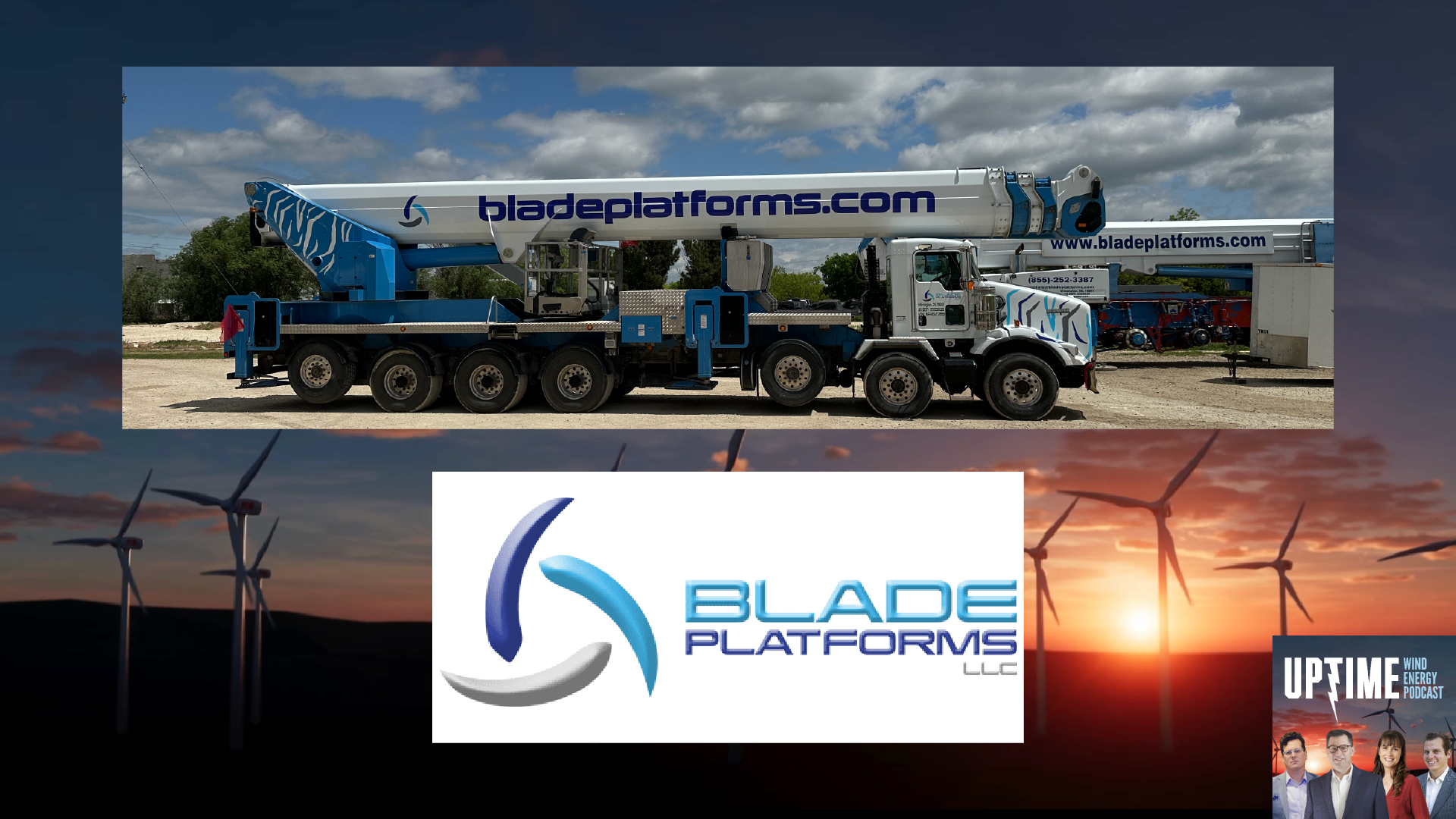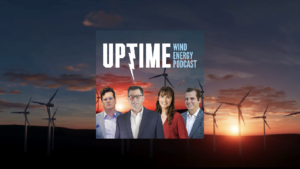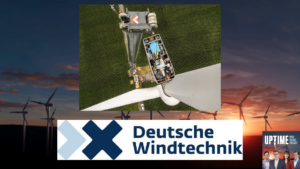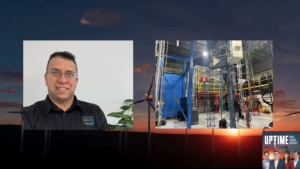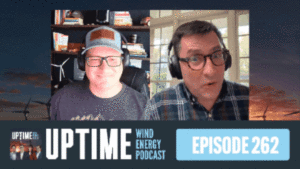Podcast: Play in new window | Download
In this episode, Petr Bartusek from Blade Platforms discusses how their truck-mounted platforms, capable of safely reaching over 100 meters, are transforming wind turbine blade repair access. With increased speed, skill utilization, and 24-hour shift capabilities, using Blade Platforms minimizes turbine downtime and maximizes efficiency in blade repair campaigns.
Sign up now for Uptime Tech News, our weekly email update on all things wind technology. This episode is sponsored by Weather Guard Lightning Tech. Learn more about Weather Guard’s StrikeTape Wind Turbine LPS retrofit. Follow the show on Facebook, YouTube, Twitter, Linkedin and visit Weather Guard on the web. And subscribe to Rosemary Barnes’ YouTube channel here. Have a question we can answer on the show? Email us!
Pardalote Consulting – https://www.pardaloteconsulting.com
Weather Guard Lightning Tech – www.weatherguardwind.com
Intelstor – https://www.intelstor.com
Allen Hall: Welcome to the Uptime Wind Energy Podcast. I’m your host, Allen Hall, along with my co host, Joel Saxum, today, we’re tackling a critical issue in the wind industry. Accessing wind turbine blades for repairs. And our guest is Petr Bartusek, commercial VP of Blade Platforms. And Blade Platforms is a truck mounted platform company based in Abilene, Texas.
And with wind turbines hubs reaching new heights, traditional repair access methods can be slow and inefficient. Blade Platforms solves this problem with a fleet of machines that can safely reach over 100 meters, allowing technicians to quickly and efficiently repair blades while minimizing turbine downtime.
Today, Petr will share how Blade Platforms is transforming blade repair access and discuss the future of this innovative company in the wind industry. Petr, welcome to the show.
Petr Bartusek: All right. Thanks for having me.
Allen Hall: So Joel and I happened to visit your facility in Abilene. And the reason we did was because of speed.
It comes down to quickness and our strike click take application where we’re touching a lot of blades, we have to get up and down very quickly because we touched so many blades simultaneously, which is a common industry problem. If you’re going to fix one blade pretty easy, you can use whatever method.
But when we’re. At some farms that have a hundred, 200, 300 plus turbines, it becomes so slow and efficient that there has to be a new way to do it, a faster way to get on blade and to make repairs. And this is where we stopped. And Abilene met with your folks down there at Blade Platforms. It is impressive the speed at which you guys move and it has really changed the industry.
And we, Joel and I have been around a lot of parts of Texas and Oklahoma and we see Blade Platforms. And now we understand why, because you’re really changing the industry.
Petr Bartusek: I’ll add, it’s not just speed, I think. There’s a couple of things. You get speed, you get skill, and you get time utilization, right?
So the speed kind of speaks for itself, right? I tell everyone on a 12 hour day, We’ll do 11 hours worth of work, right? So you got some truck set up time and, some idle time that just, you cannot monetize that, that, that’s one aspect. The other thing is utilization of time and that, these sites are, on windy projects, right?
So you’re, you don’t put turbines where the wind doesn’t blow. So you have to be able to operate in increments of time. When that happens. I use a traditional means of access or ropes or suspended platforms. It’s the rigging time and everything else that goes into it changes the dynamics of what you’re doing because, let’s say you got a rig for two hours, then you go up and you get a three hour weather window.
Then you got to go down and maybe or maybe not, you have to pull it a day. If at two o’clock a storm roll in or something will happen. So for us, we get, six hours worth of work. There’s three hours storm going through. All of a sudden we can take a, three hour lunch to kill that storm, weather a storm, and then we go work again.
So that’s what I would call the time utilization. Third aspect, which is skill or training, right? And the way I look at it is the older you get as a skilled technician, the less likely you are. To be one, I hang on the ropes. So let’s say you’re 20 year old. This is fun. You’re 40. You may have some midsection weight, you may have some bum knees.
You know, you’ve acquired a lot of knowledge and you. Basically could become a liability rather than an assets to a traditional access company. Whereas with us, if your knees a little bum, it doesn’t matter if used to be 175 and now you’re 275. It’s not that big of a deal because the basket can handle 1, 300 pounds.
So we can then effectively monetize or help our customers monetize The skill that particular technician has already built up over, let’s say, 10, 15, 20 years. So I think that those are the 3 advantages that I see. It’s the time utilization and the skill utilization that comes with it.
And I’m not even talking about the safety aspects of, being up there where, there’s 4 redundant systems or how you can get down and. You don’t have to worry about anything.
Joel Saxum: And I can speak to that too, Petr. So I know that you guys have some aid in house that can help someone with a bit of a blade issue if they need it. But if a company has technicians that they need to put up there, this is not, you don’t have to come to site and do a three day training mechanism or something when this, when the. Blade Platform’s truck shows up, there’s a technician with it, there’s a, there’s someone who can operate it I was there, like I was gonna say, I’ll speak to this we came to the Abilene facility, saw the fantastic facility when you pull in, all the trucks everywhere being worked on the army of people maintaining these things and making sure they’re ready to go at a minute’s notice, I did an orientation with one of your techs on site who was fantastic.
Rigged, the guys rigged me up for a harness and showed me where to hook off and all these things. And within 5 minutes I was up 200 and some odd feet in the air. Just a little scared, I’m gonna be honest with you. I think I was the one who actually said, Okay, that’s high enough, we’re good here. I have a beautiful view of Abilene, Texas, right from the sky.
But what I’m saying or what I’m getting at there is if you have technicians or if you have people on the ground already, they don’t need to go through a big training program to do this, right? It was literally 15 minutes of orientation, safety rigging up a harness, which if you’re in a wind industry, you already probably have your own or you know how to do it anyways.
And then Going up and you’re ready to work, right? It was like, now we’re ready to go.
Petr Bartusek: Yeah, that’s exactly it. As long as you have your basic wind search, which is your, safety GW now, which, it’s becoming the prevalent requirement it’s more of an orientation for you, Hey, here’s where you’re going to step here is where you’re going to clip your lanyard.
And then you’re good to go. And then other than that, you’ve been trained for everything. So you’re right. Our unit will roll up to site. Or whoever needs to use it, but I would call self contained. That means there is an operator in the basket. They’ll do all the work. And we also have a ground control technician.
That’s somebody who manages the ground, make sure nobody gets underneath because there is a drop zone. If something were to happen, this person can also serve as a secondary rescue. So if you’ve never seen these units as a future potential customer it’s out of sight, out of mind. Almost.
We roll in, we’d set up everything and we take your super skilled technician or inspector or whoever that needs to be and take him up and then they got to do whatever they got to do. We do have a limited capability. So helping mostly our OEM customers in house, but. Our bread and butter is truly truck rental and access and truck sales.
Joel Saxum: The majority of platforms or the majority, I’m saying platforms as in turbines, right? The majority of the turbines out in the fleet in the United States right now are, or let’s say North America in general, are under a hundred meter hub height. A lot of them, 80 meters, 90 meters for the majority of the fleet.
It’s pretty odd that you get turbines over a hundred meters. So what that means is I know that you guys have trucks at all different levels, like you have 30 meter access all the way to a hundred meter access, correct?
Petr Bartusek: Correct. Yeah, we go 30, 50, 70, 75, 90, and then 103.
Joel Saxum: That’s flipping a football field on its nose and going from the end of the end zone to the end of the other end zone.
Not the, not just the end lines, but the whole thing. That’s huge. You’re 330 feet and you’re 340.
Petr Bartusek: 336 is almost 340. These trucks are actually the highest reaching trucks that exist in North America, South America, probably in Europe.
Joel Saxum: So with these, all these different heights, right? So if you wanted to go just work on the tip of a turbine blade, great.
If you want to go up the side of the tower and look underneath the nacelle, great. If you want to go and work the whole blade length of the tower, we can do that as well. But all of these different heights also have different kind of wind restrictions to go with it, right? Because you’re not going to be up at 100 meters with a 20 meter per second wind, like that’s just not going to happen, right?
But what do the wind restrictions look like for you guys? Because I’m just looking at weather windows.
Petr Bartusek: Yeah for us traditionally, especially on a newer fleet we have what’s called an extended wind regime. So the truck is 12 and a half meters a second, 16 meters a second, and 19 meters a second that you actually can go and operate.
It may have a restricted envelope, so you may not able to hit the full reach. So 90 meter truck, you got only hit. 80 meters at 19 meters a second. And you may not hit the full outreach, which is up to 130 feet. Then you may be limited to a hundred feet on outreach, during those dicey conditions, nobody will want to do anything crazy.
And most wind farms will catch you off at 12, 12 meters a second anyway, because it’s just considered the safe. safe practice. I think for us where it comes in is that, Hey, I know the truck can handle a lot higher wind gusts. So everybody’s safe and then it allows you to finish a job in an emergency situation.
So that’s the use we’re looking at for the extended working at a low based on extended wind regime.
Joel Saxum: Yeah, because at the, in a general rule of thumb, there isn’t many turbines out there that you would even lock out after 15 meters per second. Most of them you just feather the blades negative and let it sit up there.
You’re not going to be able to work on them no matter what the access method is that’s wind speed.
Petr Bartusek: Yeah, that’s right. And, operators want to make money too. We can generate, they want to add the other day that’s their business. We get it. And again, that’s why I know we have the capability and capacity.
We don’t really, dangle the carrot much in front of people because it’s, we’re going to work to a point where it’s safe. And where are we adding value? So if, let’s say you’re working just on the tip, and you start getting 30 meters a second, we could probably still be there. The tip may be flapping to where it’s just not safe for the basket or it’s you’re just, you can be up in the air, but you’re creating zero value because you can’t actually do the work.
It depends on where you’re working on that flight. If I’m somewhere, mid span or max core, there’s a lot less movement. Okay. On that blade, so it could still be possible to finish the job, but at a tip, it just poses a whole other dimension.
Joel Saxum: Okay, so we’ve talked about 30, 30 all the way to a hundred meter reach height.
How many trucks do you guys have? What does the fleet look like?
Petr Bartusek: Pushing close to 40, it’s 35 plus. There is a pipeline of about 10 trucks being delivered each year. As we have it, we’re currently still evaluating the mix. I know this is more of a wind show, but we’ve made a huge leap into the transmission space which is adjacent market for us.
That changed our mix a little bit. We operate in other spaces too, like aerospace construction, building big stadiums and highly bridges and whatever else just needs some special equipment like this, but our bread and butter is traditionally going to be wind power.
And transmission, right? With. You’re talking about the average hub height being 80, 90 meters. Your workhorse truly ends up being a 90 meter machine which is a 295 footer. So that means that no matter what happens, you’re going to roll on the side, you can hit it and you don’t have to worry about it because it’s a, it’s an overall workhorse.
Now, if you know you’re only structuring a campaign that’s geared maybe towards strike tape and leading edge protection, Then the 50 or 70 meter variety will likely do. And, there is obviously money savings because it’s a cheaper machine to start with. But it’s going to be limited to that particular campaign that you’re doing.
Allen Hall: And what are the restrictions about moving such a large vehicle around in the United States? Are there permits and things that need to be pulled before? Bringing it some parts.
Petr Bartusek: The problem with the DLT generally is that each state has individual DLTs. There is not like a federal DLT that would make everything super easy.
So each state may have different requirements on weight, actual spacing and how much weight you can have on each axle, basically 30, 50, 70 meter variety. You can drive around the U. S. without any issues at all. That includes California which is not a super friendly state to large equipment.
The 90 meters virtually drivable everywhere except a couple states where they may need to get low boyed. And, it’s just, it’s a permit situation of 1 to 3 days wait, depending on what each state requires, and the 100 meters, they’re about 50 60. I would say about half of the states are.
Road friendly and half of the states are not. So sometimes you end up having to piecemeal Hey, we’re going to drive here. Then you’re going to put it in a low boy, fortunately own a low boy in house. So that makes moves a lot easier on us. And then, again, you get to unload it and you can drive.
It has to do with the overall weight of the vehicle or axle spacing.
Joel Saxum: But when it, when it comes to access within a wind farm, at one point in time, all of these wind farms were built with heavy trucks having to move usually big crawler cranes in, so the roads are, the roads and pads are good for you guys, the bridges, the bridge crossings, the roads around the wind farms once you get to the site, there’s, there should be no issues, no matter what the place is, unless it’s like, Hey, you can’t, put a, put an outrigger out here because the sage grouse is mating this spring or something like that.
You might run into a deal, but there’s nothing we can do about those.
Petr Bartusek: No, generally there are no issues at all. Especially if the turbine operator or, the construction company was a good steward to the County. If they were not, sometimes we walk into the hornet’s nest, they just close.
And I say, Hey, we know it’s not you guys that, that build it or, it’s. It’s not an angry landowner that, didn’t want to sign and now he doesn’t have a turbine on his field and his neighbor has five turbines and all of a sudden this guy has a brand new truck every year and neighbor doesn’t.
There’s that type of dynamic we walk into. There is some specific seasonal issues like, where there’s a little whale mating or some salamanders somewhere in California or, you’re going to have frost loss up north that, that kick in or if you had heavy rain somewhere in the Iowa cornfields or, even in the corpus area, then the ground is too soft.
So you may wait 2 or 3 days for it to dry, but yeah, no, we don’t have access issues. I think there is one site somewhere in New Hampshire that we have to get a little bit of a. So with a tractor just because the grade was relatively steep, but if any, if a truck can get there, if a car can get there, we usually don’t have issues and our truck are, all wheel drive and rear steering, so we can navigate sites pretty well.
Allen Hall: I think I’ve been to that site in New Hampshire. It is very steep. So that makes a lot of sense. So do you cover Canada as well as the United States? What’s your territory here?
Petr Bartusek: We so we specialize in the U. S. We have the ability to go to Canada. I don’t necessarily pursue it actively, passively we do it.
But there is just so much work in the U. S. for our trucks that, that to actually focus on Canada, it’s borderline counterproductive, nothing against Canadians, I like hockey and everything else. But the service window is so much shorter up there than it is stateside because of the climate and certain provinces have certain restrictions, and, French Canada being one of the harshest ones.
That it, it poses a whole new aspect in terms of, how you bill how you kind of work around labor laws, what you cannot do. So it, again, customer orders it, we’ll bring it there or bring it to the border and they can take it, we’ll deliver it. I say yes, but I don’t seek it out.
Joel Saxum: That’s a market that could greatly benefit from the efficiency of the trucks, right? But if it’s not, if it’s not good, if it’s not as good for your business model, like I get it, like just stay down here and make money where the hate.
Petr Bartusek: What they could benefit is something we discovered by accident about two years ago.
Actually, we discovered we were the beneficiary. Some of our customers discovered it and they’re saying, Hey, the machine doesn’t get tired. Why don’t we run two shifts? That’s something that probably should be utilized in Canada. That is, there is so much work that you truly cannot get everything done in a season.
And especially of the shoulder sort of season. The weather’s a little dicey. So he tried to compress everything into where she was saying may through September in an ideal case. And if everybody had their wish, it would be like June through August. So at that point, how do you.
How do you handle the limited capacity of trucks or technicians that want R& Rs and everything else that is happening? So we’ve been with a couple of our customers. We’ve been running a 24 hour shift. That means I actually have two sets of operators and they have two sets of light decks and we run around the clock.
And that truly is, we’re into what I’ve called the peak season.
Joel Saxum: Yeah, take advantage of the good weather windows, right? Yeah, we know that, like if you’re working on site, even in the U. S., once September hits and October starts looking, if you’re working anywhere north of basically South Texas, you have the possibility of snow or some other bad weather moving in, why not?
You could get two weeks worth of, Or four weeks worth of work done in two weeks if you run night shifts. That’s just makes sense.
Petr Bartusek: And with less of a standby risk, right? So your actual two weeks. Could mean six weeks in real life, right? Cause it gives you a factor, a standby.
So yeah, it’s not everyone’s receptive to it. Again, I did not invent it. I’m sure this is being used because the petrochemical industry all the time during shutdown and turnaround, but, some of our customers came to us and say, Hey, this is what we want to do. And, always figure out how to say yes.
So that is my job, virtually and then operation guys have to figure out how they gonna deliver on that.
Allen Hall: That does seem like a really good idea. And I know there’s a lot of operators that have used Blade Platforms, but there’s still a substantial number that haven’t used your services yet.
How do they reach out to you, Petr? How do they get ahold of Blade Platforms?
Petr Bartusek: So the easiest way is the 21st century, that’s www.bladeplatforms.com. That probably will guide you to our 1 800 number, or, eventually get you to someone who you’ve talked to and they can get to me. I don’t mind sharing my number.
That’s 469-371-4284. If someone needs to get me direct.
Allen Hall: If you need Blade Platforms services, go to bladeplatforms. com. Check out their website, get ahold of Petr. They are really efficient and are experts on blade upgrades and blade repairs. So this Petr, it’s been great having you on the podcast.
Thank you so much for joining. Awesome. Thank you guys. Thanks for having me.



